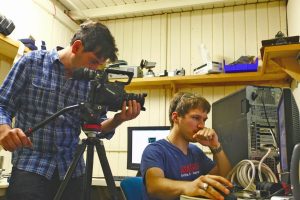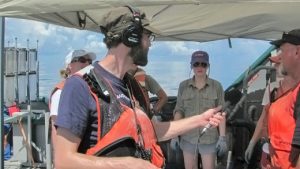Podcasts and Videos Share GoMRI Oil Spill Research with a Broader Audience
– May 22, 2013
Scientists conducting research to understand the effects of the Deepwater Horizon oil spill are increasingly using sights and sounds to share their explorations and discoveries. Using podcasts and videos, researchers are making science come to life for many to see.
Here are a few recent examples:
C-IMAGE podcast takes us onboard an eight-day research expedition
Listen to a story about chemists, engineers, and biologists working together to understand the effects of the oil spill on the marine ecosystem. This podcast features the Center for Integrated Modeling and Analysis of the Gulf Ecosystem (C-IMAGE) science team onboard the RV Weatherbird II, one of many at-sea field trips to collect samples in the Gulf of Mexico. Dr. David Hollander, a marine chemist at the University of South Florida, is the chief scientist for this cruise. Hollander and his team deploy a multi-corer on the seafloor of the Desoto Canyon about 60 miles southwest of the Florida Panhandle, one of the areas through which oil plumes traveled. C-IMAGE seeks to improve observational and predictive tools for future deep-sea blow outs in the Gulf and to understand the consequences of the oil spill. For more information, visit the C-IMAGE website and the C-IMAGE Facebook page.
CARTHE video encompasses entire consortium’s research effort
Watch this video to learn how field data and interconnected modeling come together to improve our understanding of surface currents that influence the movement and fate of pollutants in the Gulf. Researchers with the Consortium for Advanced Research on Transport of Hydrocarbons in the Environment (CARTHE) are carefully studying information to improve deployment of emergency responders in the event of future spills or at-sea emergencies. Highlights include colorful model animations and an unprecedented three-week expedition aboard the RV Walton Smith where researchers deployed 300+ custom buoy “drifters” that provided five million data points. CARTHE seeks to accurately predict the fate of hydrocarbons released into the environment. For more information, visit the CARTHE website and the CARTHE Facebook page.
This research was made possible by a grant from BP/The Gulf of Mexico Research Initiative (GoMRI). GoMRI is a 10-year, $500 million independent research program established by an agreement between BP and the Gulf of Mexico Alliance to study the effects of the Deepwater Horizon incident and the potential associated impact of this and similar incidents on the environment and public health.
© Copyright 2010- 2017 Gulf of Mexico Research Initiative (GoMRI) – All Rights Reserved. Redistribution is encouraged with acknowledgement to the Gulf of Mexico Research Initiative (GoMRI). Please credit images and/or videos as done in each article. Questions? Contact web-content editor Nilde “Maggie” Dannreuther, Northern Gulf Institute, Mississippi State University (maggied@ngi.msstate.edu).







